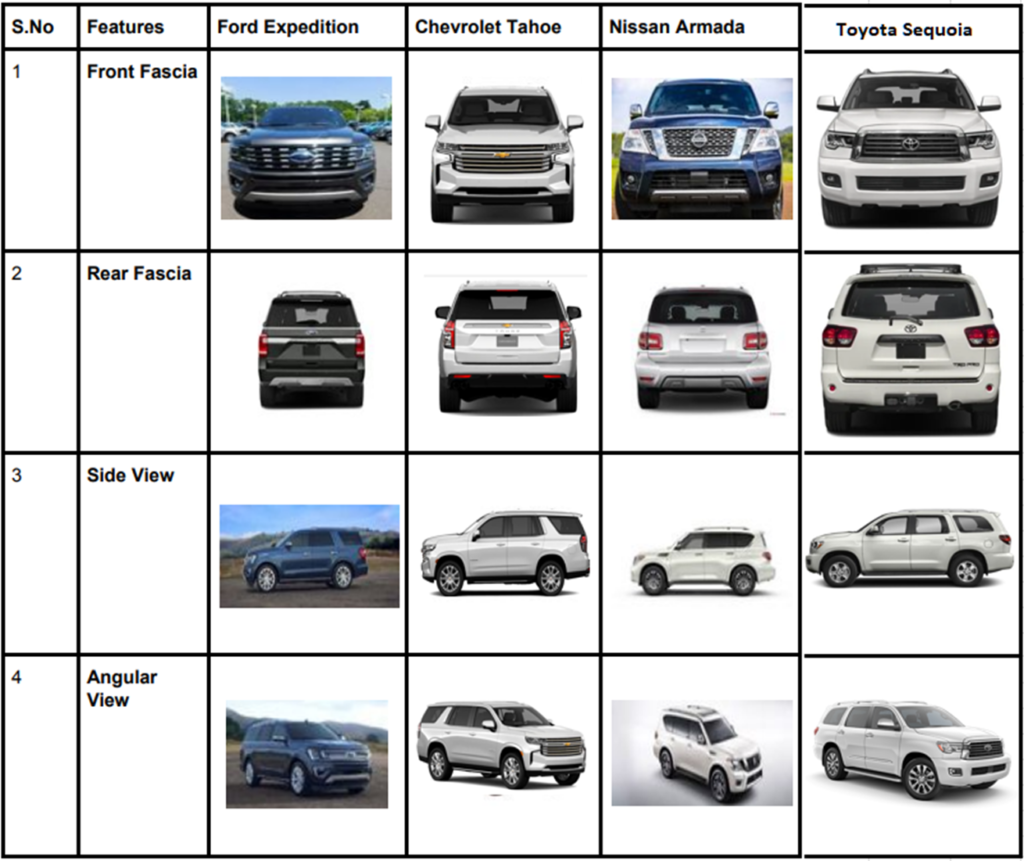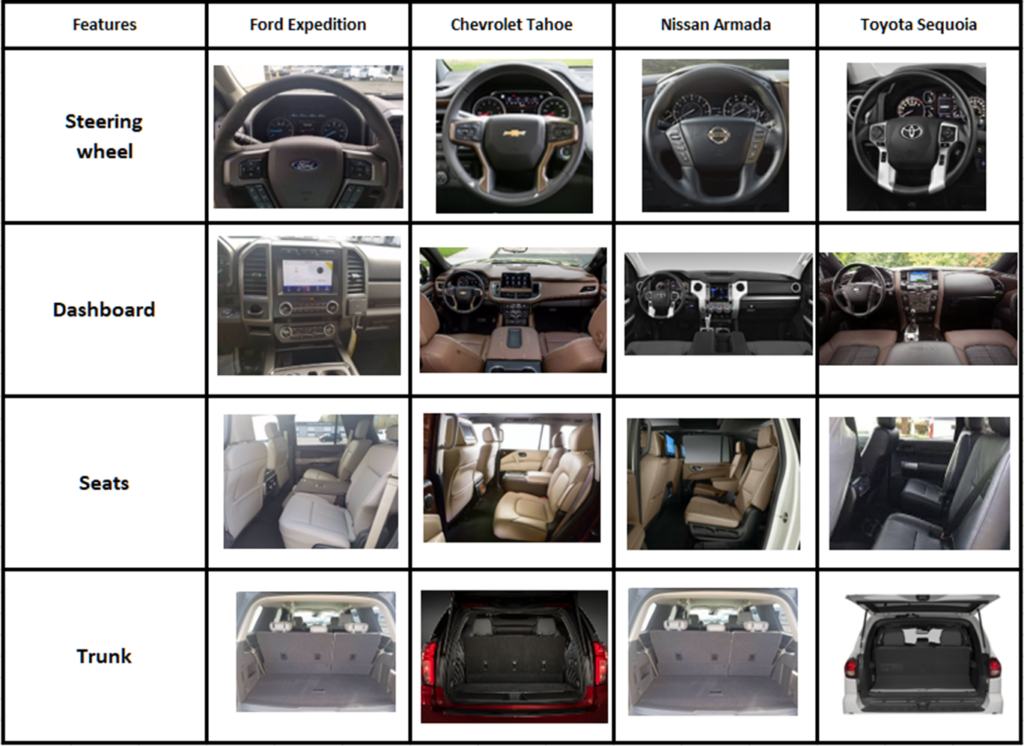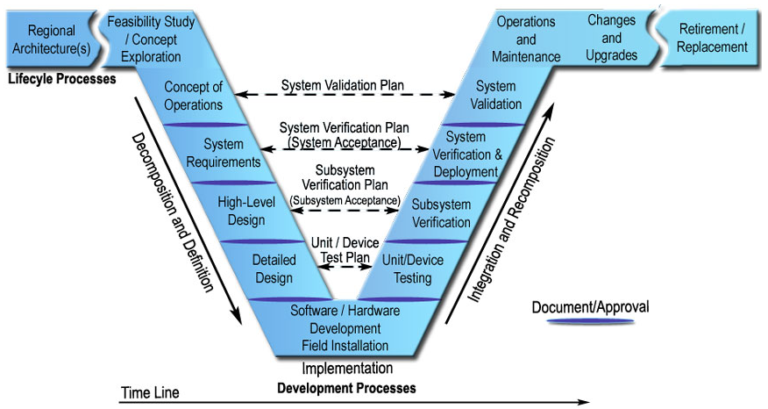Automotive Benchmarking and Preliminary Design Specifications
Background/Describe market segment
We are working on redesigning the current generation Toyota Sequoia. The Toyota Sequoia is classified as a sport utility vehicle (SUV). A SUV in a combination of a road going passenger car with features of an off-road vehicle. In the US, SUVs are categorized as “light trucks”, as a result regulations on these vehicles are a lot more lenient compared to passenger cars.
This next generation full SUV will be released in August 2025 as a MY26 Sequoia. This vehicle will only be sold in North America (US and Canada Markets only). The MY26 Sequoia will be a traditional SUV with a body on frame design. This SUV will be classified as an economy SUV with a starting price of 51,000 dollars. Based on current market trends, we have decided that this vehicle will be a fully electric full size SUV, one of the first in its class. To benchmark and ensure the success of this new vehicle, the following 3 vehicles will be studied. See competitive set below:
Competitive Set:
- Chevy Tahoe
- Ford Expedition
- Nissan Armada
These three vehicles were selected due to the fact that they have all outsold the Toyota Sequoia in the full size SUV segment. Refer to table 1.1 US Quarterly Large SUV Sales Numbers [1].

Just like the current generation Sequoia this vehicle will be able to sit 7 passengers comfortably. The total cargo room of this vehicle will increase from the current generation to increase the spaciousness of this vehicle. More details of the characteristics of this vehicle will be discussed in subsequent parts of the presentation. By selecting to transition to a BEV it is important we reference and benchmark the propulsion system of the closest size BEV to our vehicle. This will allow us to make more adequate accurate decisions about our future vehicle. The main things we want to understand from our reference set is the vehicle dynamics and its aerodynamic performance.
Reference vehicle:
- Tesla Model Y (Vehicle Dynamics & Aerodynamics)
Why should you define your customer?
When you have a target audience in mind, it becomes easier to make the right decision for your specific product you are designing. For our project our customer is:
A family man/woman with at least 2 kids between the age of 40–50 years old. They are adventurous and enjoy taking road trips in their SUV. Their hobbies include boating, riding jet skis and horseback riding, which is why they were attracted to this vehicle since they will occasionally perform some towing. They bought this vehicle because they enjoy the space, comfort, and versatility of it. This vehicle will primarily be used for daily commutes or road trips, but the customer likes the peace of mind they get when this vehicle can go off-road if they ever require it. They are well established in their career and well educated with at least a bachelor’s degree. Our customer enjoys his middle-class lifestyle, as his family income is around 80,000 a year. Our customer likes to be described as a “fun” parent who is not willing to be seen in a minivan. Our customer is forward thinking and wants to have a vehicle which is also environmentally friendly. See figure 1.B Customer Characteristics below.

What are customer needs?
The customer need are the reasons that prompt a customer to buy a product or service. These needs are the driver that guide the customer to make a purchase decision. For our project our customer are:
The customer will need enough room to fit a family of four, plus other potential guest passengers. This will likely call for a minimum of seven seats (third row of seats) to accommodate the required number of passengers. They will need enough headroom and space for all occupants to be seated comfortably within the vehicle. In addition, seats behind the first row should also be foldable to enable room for additional storage for both leisure and occupational purposes. This vehicle should have enough storage capacity to be able to hold 4 large suitcase and 4 small carryon bags. In addition, the vehicle must be capable of towing a minimum of 1500 lbs. As to ensure that it can tow an object such as a small boat/jet ski, a horse carriage, or other equipment. It must also have an adequate suspension system for an off-road drive if the customer chooses to do so. Since our target customer is environmentally conscious, an electric vehicle would be ideal, as it produces no emissions. It must have a good range to sustain potentially long drives for outdoors trips and vacations and must also have a short recharge time so it can charge the battery overnight while the customer is asleep. In addition, the vehicle must meet the structural performance set by the FMVSS to obtain a 5 star safety rating.
Major Improvements:
- Reducing vehicle emission down to 0 (switching to BEV)
- Improved aerodynamics performance (0.32 best in class for full size SUV)
- 400 Miles per charge.
- Improved user-friendly smart infotainment
- Improved Leg room for 3rd row passenger
Challenges:
Biggest challenge we are currently facing is by switching to an all-electric SUV we are taking a
negative impact to the towing capacity of our vehicle. A tradeoff between, cargo volume/ 2nd and
3rd row head room and aerodynamics. Reducing the overall vehicle mass due to the high voltage batteries.
What is benchmarking and its example?
Benchmarking is a common practice in the automotive industry, especially at the beginning of a new vehicle program. Program team measure their current vehicle against other similar size vehicle in the industry and use that data to help them create targets for future vehicle programs. See Exterior comparison, interior comparison and benchmarking table below.
Exterior comparison:

Interior Comparison:

Vehicle Characteristic
To determine the vehicle characteristics of our MY26 Sequoia we gathered key attributes and
dimension from all our completive set. Using that information, we were able to make our best
assumption at what our vehicle was going to be. We were able to determine major areas we
wanted to outshine our competitor and set ourselves apart. To see full list of vehicle attribute
please refer to Table 1.2: Vehicle Characteristics. See Figure 1.C seating arrangement
below to visually compare quality of legroom and head room of all our competitors in full size
SUV segment.
Seating arrangements:


Customer needs:

Vehicle Attributes:

Vehicle Systems:

Why will it sell?

Reference
- https://www.goodcarbadcar.net/2020-us-large-suv-sales-figures/





